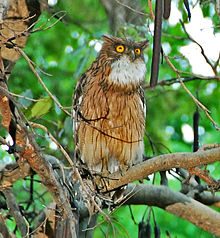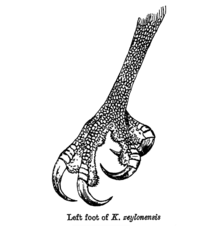- Brown Fish Owl
-
Brown Fish Owl 
Adult of subspecies leschenault
in Madhya Pradesh (India)Conservation status Scientific classification Kingdom: Animalia Phylum: Chordata Class: Aves Order: Strigiformes Family: Strigidae Genus: Bubo (but see text) Species: B. zeylonensis Binomial name Bubo zeylonensis
(Gmelin, 1788)Diversity 3–4 living subspecies, and see text Synonyms - Ketupa zeylonensis (Gmelin, 1788)
- Strix zeylonensis Gmelin, 1788
and see text
The Brown Fish Owl (Bubo zeylonensis or Ketupa zeylonensis) is an owl. This species is a part of the family known as typical owls, Strigidae, which contains most living owls. It inhabits the warm subtropical and humid tropical parts of continental Asia and some offshore islands.[1]
The four fish owls were previously generally separated in the genus Ketupa. mtDNA cytochrome b sequence data is equivocal on which genus name is applied for them, and today they are commonly lumped with the horned and eagle-owls (Bubo) – which they also resemble osteologically very much – for sake of convenience. Depending on whether some little-studied tropical eagle-owls are closer to the fish-owls than to the typical eagle-owls, Ketupa might be a valid genus if these as well as the fishing owls (formerly Scotopelia) are included in it.[2]
Contents
Description
It is a large owl with prominent "ear" tufts, typically around 55 centimetres (22 in) in length and weighing 2–2.5 kilograms (4.4–5.5 lb) when fully grown. Subspecies differ in size and males are smaller than females, with the smallest birds not quite 50 cm (20 in) long and weighing as little as 1,100 grams (39 oz).[3]
The upperparts are reddish brown and heavily streaked with black or dark brown. The underparts are buff to whitish, with dark streaks and finer brown barring. The throat is white and can be conspicuously puffed, while the facial disk is indistinct. The irides are yellow, the feet a duller yellow, and the bill is dark. Sexes do not differ in appearance except for size.[3]
Its calls are described as a deep tu-hoo-hoo or a soft huphuphuphuphuphup or a loud huhuhuhuhuhuhu.[3]
Subspecies
Three or four living subspecies are accepted today:[4]
- B. z. zeylonensis (Gmelin, 1788) – Sri Lankan Brown Fish Owl. Sri Lanka.
- Small and dark.
- B. z. leschenault[5] (Temminck, 1820) – Common Brown Fish Owl. Indian subcontinent to Myanmar (except NE) and Thailand. Might include orientalis.
- Larger and lighter than zeylonensis.
- B. z. semenowi (Zarudny, 1905) – Western Brown Fish Owl. Levant (possibly extinct) and S Asia Minor through Mesopotamia (no up-to-date observations) to Pakistan.
- Paler than leschenault. Possibly a separate species.[6]
- B. z. orientalis Delacour, 1926[verification needed] – Eastern Brown Fish Owl. NE Myanmar, Vietnam and SE China. Doubtfully distinct from leschenault.
- Darker than leschenault.
In prehistoric times, this species may have been present across the central and eastern Mediterranean basin, in particular on islands. The Late Pleistocene Bubo insularis is typically considered to include the fragmentary remains originally described as Ophthalmomegas lamarmorae due to a mix-up with the fossil macaque Macaca majori and subsequently unstudied for many decades. Its fossil bones suggest a bird the size of a large Spotted Eagle-Owl (B. africanus), a bit smaller still than the smallest living Brown Fish Owls. It was certainly smallish but long-legged by eagle-owl standards, and its wing proportions differed conspicuously from a typical Bubo. On the other hand, its leg and foot bones were more similar to those of a typical eagle-owl. Some consider them a specialized paleosubspecies of the Brown Fish Owl:[7]
- B. z. insularis[8] Mourer-Chauviré & Weesie, 1986
Its oldest remains date back at least to the Early Pliocene, about 5 million years ago (Ma). It was widely distributed around 120,000 years ago. After the onset of the last glacial period, less than 100,000 years ago, this population disappeared from the western part of its range, while in the Middle East semenowi – fossil bones indistinguishable from which are known since about the Gelasian, c. 2 Ma – would have subsumed any remnants of the eastern Mediterranean population. The Late Miocene-Early Pliocene taxon "Strix" perpasta is unlikely to belong in that genus, and also sometimes merged with B. (z.) insularis.[9]
Ecology
 Foot showing adaptations to catch fish.
Foot showing adaptations to catch fish.
This species is an all-year resident throughout most tropical and subtropical parts of the Indian Subcontinent to Southeast Asia and southeastern China; it is also found on Sri Lanka. West of its main range, it is patchily distributed to the Levant (possibly extinct) and southern Asia Minor (recently rediscovered). It inhabits mainly the lowlands, in well-wooded habitat, from open woodland to dense forest as well as in plantations; in the Himalayas foothills it ranges into submontane forest up to 1,500 m ASL or so but not higher. Western birds are found in semiarid landscape and may breed in oases in arid regions. Regardless of habitat, it rarely strays far from larger bodies of water such as rivers and lakes.[10]
This species is very nocturnal but it can often be located by the small birds that mob it while it is roosting in a tree. It feeds mainly on fishes, frogs and aquatic crustaceans; amniotes, in particular terrestrial ones, are seldom taken. If hungry, Brown Fish Owls will scavenge carrion.[3]
As mentioned above, the prehistoric B. insularis is sometimes included in the Brown Fish Owl. If this is correct, the different foot anatomy, more similar to that of a typical eagle-owl, would imply that the population had shifted back to terrestrial prey. A likely prey item in this case would have been the Sardinian Pika (Prolagus sardus). It has been conjectured that the owls disappeared with their prey due to climate change, but the giant pikas of Sardinia and Corsica still existed around 1750, finally succumbing to habitat destruction, introduced predatory mammals and overhunting soon thereafter.[11]
Brown Fish Owls breed from November to March. The clutch is one or two eggs, often placed in an old stick nest of other birds, otherwise in a rock crevice or similar. Incubation is 38 days or somewhat less, and the young fledge after about 7 weeks.[3]
The Brown Fish Owl is not considered a threatened species by the IUCN. Being a large predatory bird, it is only rarely found at a high population density. Habitat destruction will eventually cause the species to desert a region, and probably because of this it seems to be extinct as a breeding bird in Israel nowadays.[12]
Footnotes
- ^ Grimmett et al. (1999)
- ^ Mourer-Chauviré & Weesie (1986), Olsen et al. (2002), Mlíkovský (2002, 2003), BLI (2009)
- ^ a b c d e Grimmett et al. (1999), WOT (2005)
- ^ Mlíkovský (2003), WOT (2005)
- ^ Often misspelled leschenaulti[verification needed]
- ^ van den Berg et al. (2010)
- ^ Mourer-Chauviré & Weesie (1986), Pavia (1999), Mlíkovský (2002, 2003)
- ^ B./K. z. lamarmorae reactivates the nomen oblitum of the "monkey" and should not be used: Pavia (1999); see also Mourer-Chauviré, (2004).
- ^ Mlíkovský (2002, 2003)
- ^ Grimmett et al. (1999), Singh (2002), Mlíkovský (2003), WOT (2005)
- ^ Mourer-Chauviré & Weesie (1986), Mlíkovský (2002), Smith & Johnston (2008)
- ^ WOT (2005), BLI (2008)
References
- BirdLife International (2008). Ketupa zeylonensis. In: IUCN 2008. IUCN Red List of Threatened Species. Downloaded on 23 June 2009.
- Grimmett, Richard; Inskipp, Carol, Inskipp, Tim & Byers, Clive (1999): Birds of India, Pakistan, Nepal, Bangladesh, Bhutan, Sri Lanka, and the Maldives. Princeton University Press, Princeton, N.J. ISBN 0-691-04910-6
- Mlíkovský, Jiří (2002): Cenozoic Birds of the World, Part 1: Europe. Ninox Press, Prague. ISBN 80-901105-3-8 PDF fulltext
- Mlíkovský, Jiří (2003): Brown Fish Owl (Bubo zeylonensis) in Europe: past distribution and taxonomic status. Buteo 13: 61–65. PDF fulltext
- Mourer-Chauviré, Cécile (2004): [Review of Cenozoic Birds of the World, Part 1: Europe]. Auk 121 (2): 623–627. doi:10.1642/0004-8038(2004)121[0623:CBOTWP]2.0.CO;2 HTML fulltext
- Mourer-Chauviré, Cécile & Weesie, Peter D. M. (1986): Bubo insularis n. sp., forme endémique insulaire de grand-duc (Aves, Strigiformes) du Pléistocène de Sardaigne et de Corse ["B. insularis, an insular endemic eagle-owl from the Pleistocene of Sardinia and Corsica"]. Revue de Paléobiologie 5 (2): 197–205 [French with English abstract]. PDF fulltext
- Olsen, Jery; Wink, Michael; Sauer-Gürth, Heidi & Trost, Susan (2002): A new Ninox owl from Sumba, Indonesia. Emu 102 (3): 223–231. doi:10.1071/MU02006 PDF fulltext
- Pavia, Marco (1999): Un cranio di Bubo insularis Mourer-Chauviré & Weesie, 1986 (Aves, Strigidae) nelle brecce ossifere del Pleistocene di Capo Figari (Sardegna, Italia) ["A cranium of B. insularis from the Pleistocene ossiferous breccia of Cape Figari (Sardinia, Italy)"]. Atti della Accademia delle Scienze di Torino, Classe di Scienze fisiche, matematiche e naturali 133: 1–10 [Italian with English abstract]. PDF fulltext
- Singh, A. P. (2002): New and significant records from Dehra Dun valley, lower Garhwal Himalayas, India. Forktail 18: 151–153. PDF fulltext
- Smith, A. T. & Johnston, C. H. (2008). Prolagus sardus. In: IUCN 2008. IUCN Red List of Threatened Species. Downloaded on 23 June 2009.
- van den Berg, Arnoud B.; Bekir, Soner; de Knijff, Peter & The Sound Approach (2010): Rediscovery, biology, vocalisations and taxonomy of fish owls in Turkey. Dutch Birding 32: 287–298. PDF fulltext
- World Owl Trust (WOT) (2005): Brown Fish Owl. Version of February 2005. Retrieved 23 June 2009.
Wikimedia Foundation. 2010.

